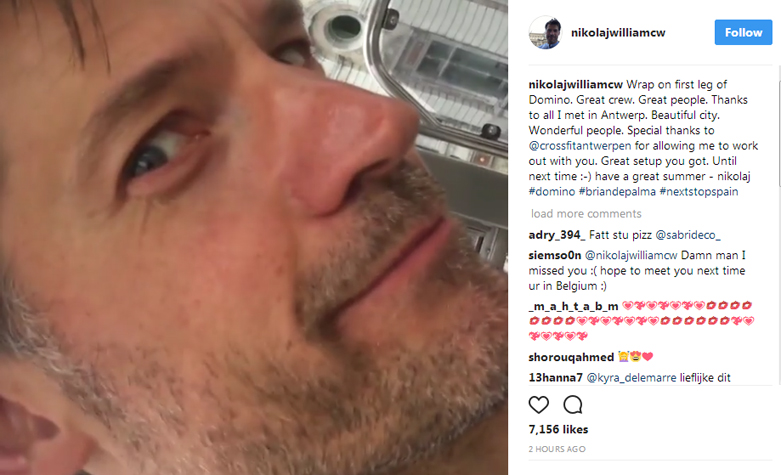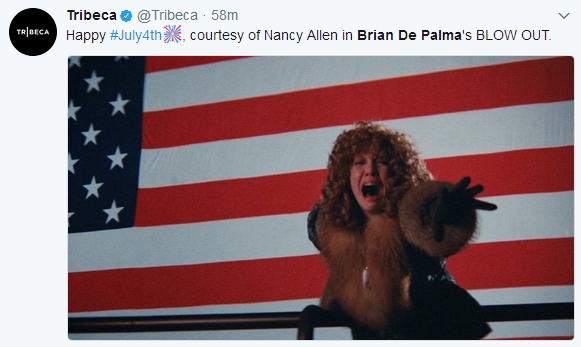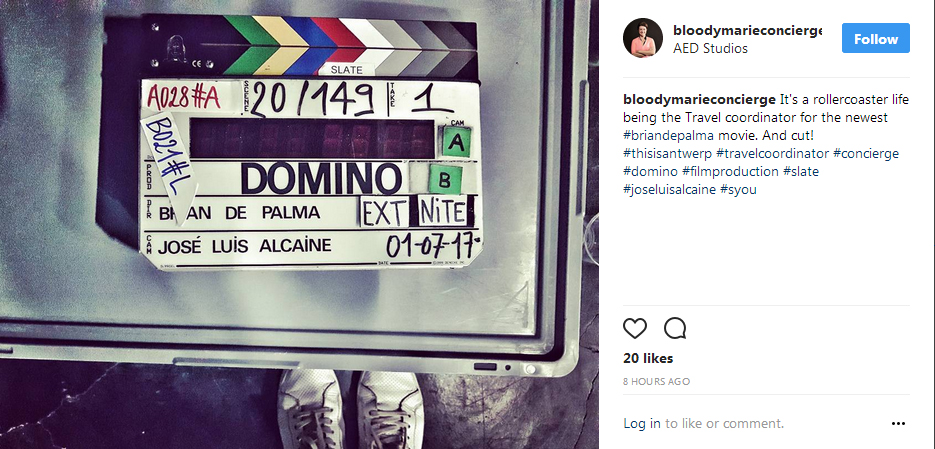MORE 'UNTOUCHABLES' LINKS, NEW BEV, ETC
GARRET MATHANY, PAULINE KAEL (FLASHBACK) & OTHERS ON 'UNTOUCHABLES', KIM MORGAN ON 'LONG GOOD FRIDAY'
The
New Beverly's recent pairing of
John Mackenzie’s
The Long Good Friday with
Brian De Palma's
The Untouchables is interesting for at least a couple of reasons. Chief among them is that
Bob Hoskins, the star of
The Long Good Friday, had been cast as
Al Capone in De Palma's film before De Palma successfully negotiated with Paramount to pay to get his first choice,
Robert De Niro, on board for the role.
The way Hoskins told the story to Absolute Radio in 2009 was that De Palma sent Hoskins the Untouchables screenplay and told him to look at Capone. "I went to meet him at his hotel," Hoskins said on the Christian O’Connell Breakfast Show, "and he said ‘really I want Robert De Niro to play him,’ and I thought, ‘well great what am I doing here?’ He then said ‘but if he don’t do it, would you sort of step in?’ and I said ‘yeah of course I will’. Anyway months went by and I read the papers and saw De Niro was doing it. I’d sort of forgotten all about it, and then Linda – my Mrs – was opening the post one morning and said ‘what’s that?’ and it was a cheque for £20,000. It said ‘thanks for your time Bob, love Brian’. [He laughed] I phoned him up and I said ‘Brian, if you’ve ever got any films you don’t want me in son, you just give me a call!’”
This was a good six years after Hoskins had made his mark in The Long Good Friday. Another reason this double feature is interesting is that Mackenzie would go on, in 1986, to direct a TV movie out of a screenplay De Palma had developed with novelist Scott Spencer in the early 1980s, Act Of Vengeance.
Here are links and excerpts from the program notes for both films, as well as a couple of other recent articles about The Untouchables:
Kim Morgan on The Long Good Friday
Watching Bob Hoskins walk through the airport in John Mackenzie’s The Long Good Friday is one of those pleasures in cinema that doesn’t happen enough these days. And, really, watching Bob Hoskins do anything – walk, talk (that voice!), whisper, prepare a creepy dinner based on his dead mother, joke, yell, fall in love or spiral into an anger so intense that his neck looks bigger than it really was (and it already was big) and with his face so engorged that it could appear perilously close to bursting. He really could be gloriously terrifying. And charming – often at the same time. He shined and charmed and intimidated and moved you with his tenderness – he’d catch you off guard with it. He had those eyes too – nothing spectacular at first sight until he started emoting – orbs that, in a state of actorly rage, Helen Mirren said looked like, “two little shiny black olives.” Honoring her fellow actor and friend who passed away in 2014, Mirren, his co-star in The Long Good Friday, continued describing Hoskins as such: “Chock-a-block with testosterone, mucho machismo, a real bloke’s bloke, built like a brick outhouse, but with a gentleness, a sweetness and a love and respect for women that was very rare then, and is quite rare now.” That’s lovely – those seeming contradictions of the barrel-chested bruiser who claimed he was never as tough as he looked. As he put it: “You don’t end up with a face like this if you’re hard, do ya? This comes from having too much mouth and nothing to back it up with. The nose has been broken so many times… Oh yeah, plenty of courage. I’m the soppy sod who got up again.” Just reading his self-description (from a terrific interview in The Guardian) makes me miss Bob Hoskins and miss his voice (if you can believe this insanity, at one point Hoskins’ voice was going to be dubbed for The Long Good Friday and the movie over-edited and dumped on TV). So watching The Long Good Friday again, and watch his swagger through the airport, that now famous opening entrance, was especially effecting. And he’s not even talking yet! I thought to myself, who is like this guy anymore? Who? And who ever was? An unlikely leading man in the vein of Edward G. Robinson, James Cagney, a bulldog (or, more, a pitbull) and that guy who either hugs or punches you (or both) after a long night of drinking, he was a stocky lug, short in stature but large in charisma, with a slangy eloquence that was rough-hewn melodious, a guy one loves to listen to – his rugged cadence was often full of wit and an energy that was both boot shaking and an absolute pleasure. Like this lovely/scary threat to a corrupt cop from Good Friday: “Don’t you ever tell me what I can or can’t do! Bent law can be tolerated for as long as they’re lubricating, but you have become definitely parched. If I was you, I’d run for cover and close the hatch, ’cause you’re gonna wind up on one of those meat hooks, my son.”
Garret Mathany on The UntouchablesWith the perfect cast in place to bring the story to life, De Palma was free to use his signature visual storytelling mastery, using long takes and his trademark-Hitchcock-influenced “creeper” sequence – shot from the killer’s point of view who is stalking the victim but doesn’t want to be seen. While the hand-held creeper sequence devoid of dialogue is always highly effective in the De Palma filmography, none evokes the emotional impact like the one that takes us through Jim Malone’s modest apartment – the climax of which solidified Sean Connery’s name on his Best Supporting Actor Academy Award. It’s a show stopper, and the most important lesson that Costner’s Ness needs to learn. The kind of lesson that Malone was trying to impart to Ness in the famous church scene that director of photography Stephen H. Burum shot from a low angle, making the two men appear larger than life, overwhelming the screen as Malone prods Ness – “What are you prepared to do?” Ness’s answer – “Everything within the law,” will fall woefully short to bring down Capone. The irony of the bloodshed that Malone forewarns will be the result of Ness’s crusade, while the two men speak of violence in a house of God, was a set location suggested to De Palma by Connery himself. This connection to the material was a perfect example of the veteran actor shepherding the characters not only onscreen, but off-screen as well. Burum originally wanted to shoot the film in black and white, but after De Palma explained that the studio would never go for that, he instead came up with a “compositional plan to shoot repetitive images.” In a kind of Kubrick-esque pattern, he set up shots with the same make of car lined up in identical formations on both sides of the street, creating a sense of period familiarity without overwhelming us with colors and busy sets. Burum also employed framing with a lot of “negative space” to remind the audience that things were still evolving, and there weren’t as many people jammed together in an urban environment like there was 30 years ago when the film was first released. Location Scout Eric Schwab and Visual Consultant Patrizia von Brandenstein return Chicago to its prohibition history, with essential locations that keep us in the film’s time period. The two were key contributors to the authenticity of the film’s period look, and put the green screen and computer mate backgrounds of today’s movies to shame.
When the production couldn’t afford to bring to life Mamet’s train collision at Union Station as it appeared in the script, De Palma shows off a bit, crafting the Odessa Steps homage from Sergei Eisenstein’s Battleship Potemkin (1925), forcing Costner and Garcia to deal with a baby carriage and its tiny passenger as it makes its way down the Union Station stairs, while they are engaged in a gun fight with Capone’s men. De Palma knew that it’s one thing to blow a cute girl with pig-tails to smithereens, but it’s something else all-together to have a baby killed. Who says De Palma films are too violent?
De Palma and Mamet created an opera with De Niro as a cherubic “Pagliacci” character that is both jester and royalty, and no opera is complete without costumes to enhance the story and the music that tells it – with Marilyn Vance nominated for Best Costume Design (Vance always took exception to the Armani credit) and Ennio Morricone nominated for Best Original Score. For all the film’s smart camera moves, genre raising script, slick production design, and standout performances, the key to the film is Morricone’s score. The sweeping music lifts you out of your seat, while the driving intensity pins you to it. His five note piano march builds suspense while the sharp notes of his haunting, hair raising harmonica, informs us that something wicked is lurking, and on a dime Morricone turns the Post Office raid into a pride filled victory for Ness’ crew, with a colorful musical exclamation mark of what would’ve otherwise been a simple scene unto itself. It’s incredible work by the genius composer.
The Untouchables is a handsome, incredibly satisfying film experience, that continually one-ups itself, and even the violence has a brilliant polish to it we can’t turn away from. The film sits on De Palma’s Mount Rushmore, remaining every bit as stylized in the crime genre as Tim Burton’s Batman that followed in 1989, or the comic book color palette of Dick Tracy in 1990, ranking among one of the decade’s finest crime films.
Critic's Notebook: The Untouchables 30 Years Later
by John DeFore, The Hollywood ReporterWhen I first saw The Untouchables as a teenager, I had never heard of Sergei Eisenstein or the Odessa Steps sequence that Brian De Palma masterfully cannibalized for the film's Union Station set-piece shootout. I knew serious actors sometimes transformed their bodies for a part, but never realized — until reading that Robert De Niro wore silk boxers to help identify with Al Capone — the lengths some went with preparations the audience would never see. And I'd never heard of its screenwriter, David Mamet, whose voice I'd soon encounter in both the plays others turned into movies (Glengarry Glen Ross) and the films (The Spanish Prisoner) he crafted from scratch as writer-director. De Palma brought these and other highbrow elements together in a movie so well paced and entertaining that a budding cinephile could watch it on a sofa with friends whose tastes barely stretched beyond action blockbusters and broad comedy. The director had been smarting-up sleazy genre pictures for years by the time he made it, and had enjoyed success with the controversially violent Scarface; but here, almost 20 years into his career, was a four-quadrant hit like (if smaller than) those made by his contemporaries Lucas, Spielberg and Coppola. In terms of mainstream appeal, the only picture he would ever make to compete with it was the first Mission: Impossible.
Pauline Kael reprint from The New Yorker at The Stacks:
The Untouchables Is Too Neat To Be A Truly Great Gangster MovieThe Untouchables is a dream of gangsters in Chicago. It isn’t De Palma’s dream, though. This isn’t a “personal” movie. He isn’t the voluptuary satirist here that he is in Carrie or Dressed to Kill or the hallucinatory The Fury; he isn’t the artist that he is in Blow Out. And The Untouchables doesn’t have anything comparable to the romantic lushness or the obsessive, sensuous rhythms that Leone brought to Once Upon a Time in America. The picture is more like an attempt to visualize the public’s collective dream of Chicago gangsters; our movie-fed imagination of the past is enlarged and given a new vividness. De Palma is a showman here. Everything is neatly done in broad strokes—the gangsters’ bulging bodies in their immaculately tailored suits, the spats and fedoras, the tommy guns and gleaming cars, the gilt on the furniture, the deep, plushy reds of the blood. And the slight unbelievability of it all makes it more enjoyable. De Palma has been developing a great camera technique, and in this movie—it’s his 18th—he uses it more impersonally than in the past. He’s making a self-consciously square movie. He works within the structure of Mamet’s moral fable, and Mamet is a master of obviousness. This writer is all deliberation—his points are unavoidable. Yet his characters have a fullness: you get what you need to know about each one. His dialogue is pointed; it has tension. And the scenes have a satisfying economy. He’s a good engineer, and his construction provides De Palma with the basis for reaching a broad audience. De Palma employs this engineering without being false to his own sensibility. He puts almost no weight on Mamet’s moralism. (The film isn’t at all like the Mamet-Lumet The Verdict.) De Palma doesn’t press down on the scriptural language—he uses it as much for its rhetorical color as for its import—and when Ness makes a speech about how the war with Capone has changed him, De Palma glides over the words.
De Palma’s resistance to Mamet’s heart-tugging devices results in a neutral tone in some of the scenes. (The mother of a little girl who has been killed by a gangland bombing comes to see Ness to encourage him in his efforts; there are interludes of Ness at home with his wife and small daughter to show us the domestic tranquility he’s trying to protect; and his wife puts little notes in his lunch bags telling him how proud she is of him.) But if De Palma’s cool neutrality is infinitely preferable to the cloying emotions that other directors might have piled on to scenes such as the one where the little girl is killed by the bomb (she might have been a bonny little lass), it nevertheless creates dead spots. At times, you feel that he’s going through the motions pro forma, in order to preserve Mamet’s structure. Yet De Palma takes such pride in camera angles and the organization of the shots that even the dead spots are likely to have some visual life. (The cinematographer, Stephen H. Burum, uses Panavision to spectacular effect. The imagery, though, isn’t always backed up by the music; every now and then you wonder what Ennio Morricone’s throbbing disco-synthesizer beat is doing in this period.)
De Palma demonstrates his technical command in a stakeout on the marble staircase of Union Station, where Ness and his sharpshooter have gone, hoping to grab Capone’s bookkeeper. They’ve been tipped off that he’s going to try to slip out of town, and they know that he’ll be escorted by gunmen. A young mother is struggling up the steps with two suitcases and a child in a cumbersome old-fashioned baby buggy. Ness, positioned at the top of the stairs, keeps looking down at her progress, knowing that she’s going to be right in the line of fire, and De Palma has the beautiful effrontery to make us experience Ness’s anxiety in suspended time, as in the instant of a car’s skidding into a tree. He holds sound in suspension, too: the shooting is punctuated by the noise of the buggy as it rolls down, clattering slowly, step by step. The sequence deliberately evokes the Odessa Steps montage in Potemkin. It doesn’t involve crowds and armies, though—only a small number of people—and it isn’t meant to be taken as real life. It’s a set piece, and when it’s over, you want to applaud De Palma for having the nerve to bring it off.
 Il Gazzettino's Adriano De Grandis reports today that Pino Donaggio will compose the score for Brian De Palma's Domino, which is getting ready to begin the second leg of filming this month in Almería. Donaggio is quoted in the brief blog post: "I'm happy to go back to work with my friend Brian, a relationship that I believe has been very satisfactory for both of us." Donaggio and De Palma are pictured here (as in the Gazzettino post) from about five years ago, when they worked together on Passion.
Il Gazzettino's Adriano De Grandis reports today that Pino Donaggio will compose the score for Brian De Palma's Domino, which is getting ready to begin the second leg of filming this month in Almería. Donaggio is quoted in the brief blog post: "I'm happy to go back to work with my friend Brian, a relationship that I believe has been very satisfactory for both of us." Donaggio and De Palma are pictured here (as in the Gazzettino post) from about five years ago, when they worked together on Passion.

















